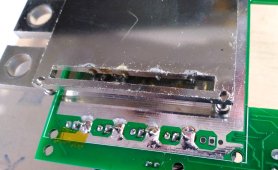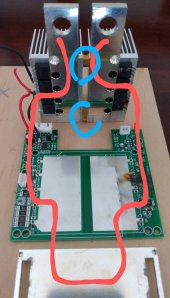Hi
@Joe85,
If I recall, that flashing LED scenario is what happened when I blew up a DCC-300 (see page 24 of this thread for details and more photos). What was the golf cart doing when this happened? If you were trying to accelerate under a heavy load (maybe floored it from a stop going up a steep hill?) the battery current would be quite high. If you tripped the overcurrent limit and the DCC-600 tried to disconnect the batteries that might fry it. Same if the battery voltage sagged too low and it tripped on under voltage. It sounds like it's fried and will need to be replaced or repaired.
Check the overcurrent limit setting in the BMS. If it is set too low for the DCC-600, that could have caused it to disconnect. In that case, you would have to power cycle the BMS to get it to come back on. If it disconnected due to low voltage, you would not need to power cycle the BMS to see it try and turn on the DCC. This low voltage disconnect scenario seems more likely to me.
Obligatory Disclaimer:
Keep in mind that there is a lot of power stored in your batteries. Unless you have the appropriate level of skill and knowledge don't try this at home! You could be burned, blinded or die.
Pretty sure an over current disconnect under an extremely heavy load is what happened to mine. There were obvious signs of damage around the power transistors. You should be able to see this kind of damage by removing the top half of the case and looking at the edge of the PCB under the heatsink.
I was able to disassemble the unit I fried and have ordered some replacement MOSFETs. The trick is to clip all the MOSFET leads right at the PCB and remove the whole MOSFET heatsink assembly. Be careful not to break the small areas of glue that are holding the two heatsinks spaced apart. Then desolder the leads remaining in the PCB and clean out the holes to insert the new MOSFET leads. This assumes you will replace all 8 MOSTFETs on the DCC-300 (there are probably more on the DCC-600). The MOSFETs have to be attached to the heatsinks before they are soldered to the PCB.
You can probably remove the MOSFETs without removing the large slotted copper plate on the back of the PCB but I didn't realize that at first. If not, clip the MOSFET leads that are soldered to the copper plate on the back of the PCB. Next, slip something thin between the PCB and the copper plate at one corner and heat the copper pads on the PCB that are touching the plate one at a time. The copper plate on mine was just barely soldered to the PCB traces where the leads came up and attached to the copper plate. With a little tension, heating the traces allowed the plate to pop loose. Be cautious and start at one corner. Here's what it looks like after I removed the plate and placed it upside down on the PCB so you can see the soldered areas.
View attachment 88937
The DCC-300 uses 8 MOSFETs from Oriental Semiconductor.
View attachment 88938
They are N-channel, 60V, 200A (600A pulse) with RDSon=2.5mOhms. Part number SFS06R02P. The datasheet is here:
GreenMOS,

www.orientalsemi.com
There was one seller of this part on AliExpress when I looked but due to counterfeit semiconductor concerns, I opted for a similar device from Digikey: IRFB3207PBF. The specs are not exactly the same, but probably close enough. I'll find out in another week or two.






